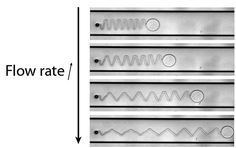Soft microflow sensors†
Abstract
We present a rapid prototyping method for integrating functional components in conventional PDMS microfluidic devices. We take advantage of

a
Laboratoire Physicochimie Curie, CNRS/UMR 168, 11 rue Pierre et Marie Curie, Paris, France
E-mail:
rafaele.attia@curie.fr, jean-louis.viovy@curie.fr
Fax: (+33) 1 40 51 06 36
Tel: (+33) 1 56 24 68 44
b
Department of Chemical Engineering, Massachusetts Institute of Technology, 77 Massachusetts Ave., Cambridge, MA, USA
E-mail:
pregibon@mit.edu, pdoyle@mit.edu
c
PMMH laboratory ESPCI-CNRS UMR 7636-Université Paris 6-Université Paris 7, 10, rue Vauquelin, Paris cedex 05, France
E-mail:
denis.bartolo@espci.fr
We present a rapid prototyping method for integrating functional components in conventional PDMS microfluidic devices. We take advantage of

 Please wait while we load your content...
Something went wrong. Try again?
Please wait while we load your content...
Something went wrong. Try again?
R. Attia, D. C. Pregibon, P. S. Doyle, J. Viovy and D. Bartolo, Lab Chip, 2009, 9, 1213 DOI: 10.1039/B813860E
To request permission to reproduce material from this article, please go to the Copyright Clearance Center request page.
If you are an author contributing to an RSC publication, you do not need to request permission provided correct acknowledgement is given.
If you are the author of this article, you do not need to request permission to reproduce figures and diagrams provided correct acknowledgement is given. If you want to reproduce the whole article in a third-party publication (excluding your thesis/dissertation for which permission is not required) please go to the Copyright Clearance Center request page.
Read more about how to correctly acknowledge RSC content.
 Fetching data from CrossRef.
Fetching data from CrossRef.
This may take some time to load.
Loading related content
